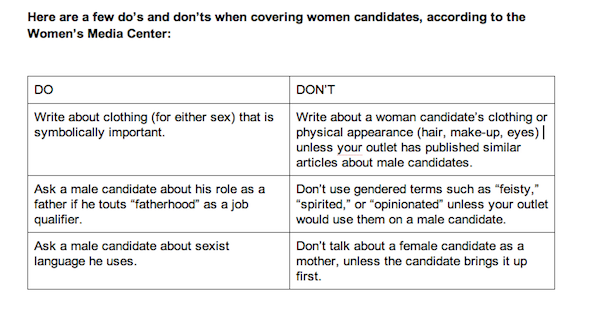Let’s face it: Maybe with the exception of New Jersey Governor Chris Christie, news media focus more on appearance for female candidates than they do for men. From the odd banter about former Secretary of State Hillary Clinton’s ankles during a 2011 Fox News discussion on the killing of Osama Bin Laden to a May 2013 NPR story about changing how the military handles sexual assault cases that described US Sen. Kirstin Gillibrand as “beautiful,” “petite, blond, and perky” with a “soft, girly voice.”
Neither Clinton’s or Gillibrand’s physical attributes were relevant to either of the above news reports.
“Even when positive, appearance coverage triggers something in voters that they don’t like and the respect for women candidates goes down. Men don’t have this issue very often,” Rachel Larris, communications manager for the Women’s Media Center, said during a panel discussion on covering female candidates Tuesday night in Washington, DC.
From Wendy Davis to Sarah Palin to Hillary Clinton, more and more women are entering high-profile political races and defending their seats. But as their numbers grow, media coverage becomes more complicated. Female candidates are becoming a normal part of the election cycle, and so are media gaffes. The panelists, who included a political reporter for Huffington Post, a woman who recently ran for office, and an advocate who works to increase the number of women public office holders, grappled with whether writing about a female candidate’s clothing on the campaign trail is sexist or a telling detail; the kind of questions women get that men don’t; and if highlighting a female candidate’s role as a mother is humanizing or a double standard.
Journalists should only report on a political candidate’s appearance, marital status, or discuss her children when it is relevant to the policy being discussed or if the candidate leads with it herself, according to advocates working to eliminate sexism in media coverage.
According to a guide published by the Women’s Media Center:
–Members of the media should be aware of sexist language and gender-based attacks, and make note of it for their audiences when candidate-to-candidate sexism appears;
–Awareness is the best tool for combating sexism. This means reporters should be aware of common sexism normalized by an unequal culture as well as of their own notions about gender, language, and image, as well as how others express these notions;
–Don’t blame the victim. When a female candidate says she’s being treated in a sexist manner, the most damaging response is a form of blaming the victim (i.e. “She’s playing the gender card”).
Women are still very new to politics when considered in a historical context, which means they are oftentimes challengers in political races, trying to make inroads in seats that had been mostly male. Male candidates benefit when the media covers their female opponents with a focus on gender, reporting on her clothing, makeup, or hair instead of her readiness for the office. Sexist coverage diminishes the woman’s qualifications, according to Name It. Change It., a joint project of the Women’s Media Center and She Should Run, which works to increase the number of women in public leadership.
The project produced two studies, one in 2010 and the other 2013 that analyze the impact of appearance coverage on candidates as well as likely voters.
“When a woman candidate’s looks become part of the election story, she loses ground,” the study states. “It may be more fun to focus on a woman’s shoes than her views, but this coverage has real impact on women candidates.”
No man can relate more to news reports about outward appearance than Christie. Some reporters argue that it is legitimate to ask questions about the health and fitness of a potential US president, but Larris dismissed such claims because, she said, many of the news stories have nothing to do with Christie’s health.
Still, men like Christie are not impacted as negatively by appearance coverage as women, said Erin Cutraro, vice president and political director of She Should Run.
“For every one Chris Christie example, I can point to 100 examples of women’s appearance being covered because it is the default,”Cutraro added.
Women politicians also tend to fall into the “mommy trap,” a catch-22 phenomenon that has impacted Wendy Davis, Democratic candidate in the Texas gubernatorial race. Davis has been criticized, particularly by conservative bloggers and publications, for abandoning her children to attend law school.
“You’re damned if you do and you’re damned if you don’t,” said Jennifer Boysko, former Democratic nominee for the Virginia House of Delegates. “Women who don’t have children are deemed as soulless and they don’t care about children, but darn it, if you’re a mom, then then it’s, ‘Why aren’t you at home taking care of your kids?’ You don’t hear this much when talking about men.”
Sabrina Siddiqui, politics reporter at The Huffington Post, said in Davis’ case, she thought it was okay for the media to raise questions about the candidate’s biography, just as long as journalists stuck to the point that Davis had “built a campaign around these facts in her story.”
Cutraro agreed that questions about Davis’ children are fair game if a candidate leads with that herself. The key, Cutraro said, “is finding that careful balance that that isn’t the story alone.”


